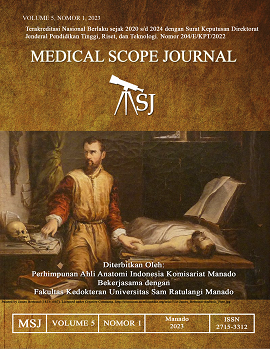Fibrocystic Breast Tumor: A Case Report
DOI:
https://doi.org/10.35790/msj.v5i1.46215Abstract
Abstract: Fibrocystic breast tumor is the most common benign type of breast diseases that affects millions of women worldwide. Fibrocystic breast changes are classified as non-proliferative, proliferative without atypia, or proliferative with atypia. We reported a 34-year-old woman presented with a right breast evaluation of breast tumors since one year before admission. On examination, a solid and hard breast tumor measuring 15x10 cm was palpable, well-defined, tender, mobile, and no nipple discharge. The patient underwent two times of core biopsy and the results were fibrocystic changes. Although clinically the breast tumor had a malignant appearance, but the results of core biopsy examinations revealed fibrocystic changes. The patient was managed by wide excision of the evaluated breast tumor with preservation of the breast skin and nipple areolar complex to maintain its function and aesthetic. In conclusion, evaluation of breast tumors must go through a triple diagnostic procedure namely clinical, imaging, and histopathological examinations. Fibrocystic breast tumor can be managed with wide excision of the tumor with preservation of the skin structure and nipple areolar complex of the breast to achieve a natural aesthetic.
Keywords: fibrocystic breast tumor; wide excision of tumor; evaluation of breast tumors
References
Sinn HP, Kreipe H. A brief overview of the WHO classification of breast tumors, 4th ed, focusing on issues and updates from the 3rd ed. Breast Care (Basel). 2013;8(2):149-54. Doi: 10.1159/000350774. PMID: 24415964; PMCID: PMC3683948.
Malherbe K, Khan M, Fatima S. Fibrocystic breast disease. [Updated 2021 Oct 24]. In: StatPearls [Internet]. Treasure Island (FL): StatPearls Publishing; 2022 Jan. Available from: https://www. ncbi.nlm.nih.gov/books/NBK551609/?report=classic
Kowalski A, Okoye E. Breast cyst. [Updated 2021 Dec 13]. In: StatPearls [Internet]. Treasure Island (FL): StatPearls Publishing; 2022 Jan-. Available from: https://www.ncbi.nlm.nih.gov/books/NBK 562196/
Vorherr H. Fibrocystic breast disease: pathophysiology, pathomorphology, clinical picture, and management. Am J Obstet Gynecol. 1986;154(1):161-79. Doi: 10.1016/0002-9378(86)90421-7.
Greenblatt RB, Samaras C, Vasquez JM, Nezhat C. Fibrocystic disease of the breast. Clin Obstet Gynecol. 1982;25(2):365-71. Doi: 10.1097/00003081-198206000-00019.
Wu C, Ray RM, Ming GL, Dao LG, Horner NK, Nelson ZC, et al. A case-control study of risk factors for fibrocystic breast conditions: Shanghai Nutrition and Breast Disease Study, China, 1995–2000. Am J Epidemiol. 2004;160(10):945–60. Available from: https://doi.org/10.1093/aje/kwh318.
Yadav P, Sharma A, Singh L, Gupta R. Management of fibrocystic breast disease: a comprehensive review. J Adv Sci Res. 2020;11(4):30-7.
Myers DJ, Walls AL. Atypical breast hyperplasia. [Updated 2022 Feb 10]. In: StatPearls [Internet]. Treasure Island (FL): StatPearls Publishing; 2022 Jan-. Available from: https://www.ncbi.nlm. nih.gov/books/NBK470258/
Mariotti C. Oncology Breast Surgery. Italy: Springer-Verlag; 2014.
Rahman GA, Adeniji KA. Clinicopathological relationship between fibrocystic disease complex and breast cancer: a case report. J Surg Tech Case Rep. 2010;2(1):54-5. Doi: 10.4103/2006-8808. 63729.
Georgescu T, Naftali Z, Simu G, Nistor V, Craciu C, Ilniczky P, et al. Retrospective studies on the relation between fibrocystic disease and cancer of the breast with therapeutic conclusions. Chirurgia (Bucur). 1992;41(1):10–8.
Downloads
Published
How to Cite
Issue
Section
License
Copyright (c) 2023 Ferry Kalitouw, Christian Manginstar, Melfrits Siwabessy

This work is licensed under a Creative Commons Attribution-NonCommercial 4.0 International License.
COPYRIGHT
Authors who publish with this journal agree to the following terms:
Authors hold their copyright and grant this journal the privilege of first publication, with the work simultaneously licensed under a Creative Commons Attribution License that permits others to impart the work with an acknowledgment of the work's origin and initial publication by this journal.
Authors can enter into separate or additional contractual arrangements for the non-exclusive distribution of the journal's published version of the work (for example, post it to an institutional repository or publish it in a book), with an acknowledgment of its underlying publication in this journal.
Authors are permitted and encouraged to post their work online (for example, in institutional repositories or on their website) as it can lead to productive exchanges, as well as earlier and greater citation of the published work (See The Effect of Open Access).










